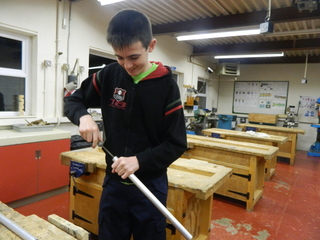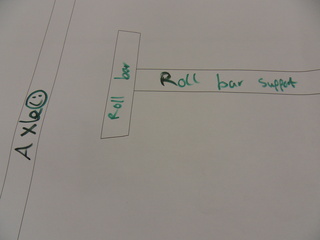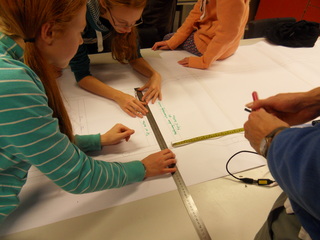Diary: Rotary Racer 9 Build
2013-06-09: The first race, Goodwood
|
It was all a bit rushed in the end to get it ready for the first race. Mind you it always is. Just like any engineering project, the amount of work almost always exceeds the expectation. However our overall planning and attempt to keep to a schedule worked, just. A few last minute finishing bits on the Saturday before the race (till 11:30pm ...) sorted the main bits so it could race. We managed to do the obligatory tilt test and all safety related items were checked. But real testing of the car under power had to wait for the practice session at Goodwood :( |
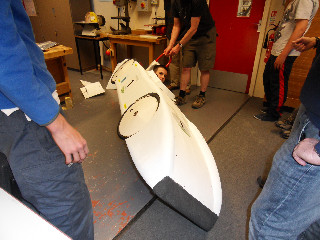 |
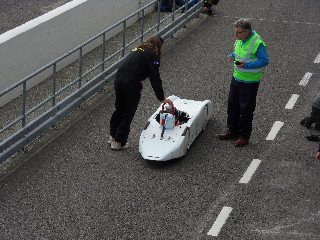 |
The car was still missing lots of aerodynamic parts, especially the behind drivers head fairing, roll-bar airfoils and rear wheel covers. The cars surface was like sandpaper after the rough first coat of paint. But it rolled, braked, steered and the wheel turned when the throttle was open. Gearing was set up based on the old car at Goodwood, but with a degree of conservatism and with the speed controller we could always reduce power levels as needed. Scruiteneering was passed without a hitch (phew!) and we managed to get the car to the practice session relatively early on. And it actually went. |
 |
 |
|
And the car went superbly well, especially for the first race. It kept on going and driver feedback was good (a bit more bumpy than the last car). In fact it went so well that it managed 3rd place in the F24+ race, its first race. It didn't run so well in the F24, but we were using old batteries, had 7 drivers with new ones having their first go (well done Becky). But still the car went well and didn't break down. So a great success. We now have our base platform and the work really begins. How to engineer it to be more efficient and go further and faster. |
 |
2013-06-06: The Painting
| First some quick testing of the cars steering and brakes along with Becky's first drive of a Greenpower car. It all worked, but the new brake calipers need some bedding in. |
 |
|
Thursday night was painting night. I'm afraid one of the things that has not improved yet on Rotary Racer is the paint job. Again we have used our trusty and cheap method of white kitchen emulsion. Its only going to get one coat before the first race and no sanding, so will be quite rough. Maybe later in the year we will manage something better, but engineering is our focus :) Its amazing how much paint ended up on other things than the car, like the disk calipers, the joystick ... |
 |
 |
 |
| Also we had forgotten the new rules about a maximum of 30mm of insulation foam in the battery boxes. So some more last minute jobs were added to the list and carried out. Its all getting a bit tight with just three days to go before the first race. It certainly won't be finished, but should be driveable. Actually this will really be a test day for us (although some of the team don't have that view :) | |
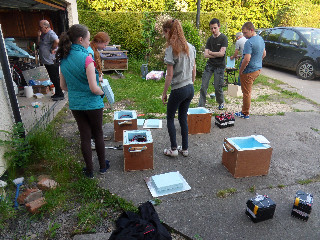 |
 |
2013-06-04: Aluminum motor protection and battery box bits
|
The Aluminum motor panel was cut out and fitted. Time is now getting tight and exam season is not helping. Greenpower sessions are now being used as a break in revision :) Work is being done both in Greenpower sessions at school and at garages on odd evenings. |
 |
|
The electronics was fitted into the rear box. The electronics from RR8 is being used first off. However we hope to improve this in the coming years. We are using essentially the same software as for RR8 but with the Telemetry RX wire cut so no remote digital control by pupils in the pits due to the bad rule change :( |
 |
|
Some work on fitting the internal 1mm plywood panels at the front of the car and some work on the battery box and tail area was carried out. Wiring work was commenced with crimping connectors onto the thick battery wire. Aluminum side impact panels were pop riveted to the aluminum chassis and internal driver side foam cut and fitted. |
|
.jpg)  |
.jpg)  |
2013-05-27: The sides are shaped
|
The half term holidays saw the shaping of the foam sides to match Gareths 3D design drawing. Liberal use of a power plane and sandpaper were called for. Martins garage was used for the messy job. We weren't going to make the tail for the first Goowood race. But when Jeremy mentioned the Americans were coming Gareth decided to make one :). It is exam time Gareth ... |
 |
 |
 |
2013-05-21: The body and Carbon Fibre
| The bottom plywood of the car was strengthed with carbon fibre where the batteries are installed. This used two layers of carbon fibre/kevlar cloth with 3mm of hard foam between. Epoxy resin was used to bond it all together. This is a trial of using carbon fibre construction techniques. We hope to use this for other body parts as we gain knowlege of the process. |
 |
| The area beneith the driver was also strengthed with carbon fibre/kevlar cloth as drivers step in at this location. It also provides a dgree of protection to the drivers back. A layer of carrymat foam will improve this protection further. |
 |
|
The main bodywork uses foam as in RR8. This was Floormate 300-A 50mm. Unfortunately it is difficult to get hold of these days, but we had two sheets left over from RR8 and fould a single sheet in a Cardiff SIG store. All of the cars functional parts are now complete. |
 |
     |
|
2013-05-17: Its coming together
Its all getting a bit close to the first planned race, Goodwood 9th June. However a lot of the core complex work has been done so there is a chance. We started taking some bits off the old RR8 to speed up the final work. Our trusty old circuit breaker which I think has been on all RR cars since the first car was one of the items removed..jpg) Marks a turning point, we have moved to the new car!
Marks a turning point, we have moved to the new car!
The steelwork subframes and steering parts are all welded and so was given a quick coat of paint to stave off the rust (Knowing how wet Greenpower races can be !)
On Friday we did some catch up work in a parents garage. We managed to bolt the steering bits and rear axle/rollbar frames to the car chassis and actually get a rolling car!
Most of the bits came together well, the disk caliper mounts aligned well with the disks and we have brakes. The steering track rods were made and fitted and the front wheels are reasonably aligned, some fine tuning with adjusting the rose joints to be done yet, but it is looking good. The steering geometry uses close to center point steering with an 18 degree inclination and a 4 degree caster angle. The Ackerman angles were calculated using an on-line calculator.
  |
All hands to the spanners ! |
| The motor mount works well and the motor actually fits in the small space it has behind and under the driver. It uses a similar alternator style mount that worked so well in RR8, but with some simplifications and weight reduction. We have gone for 8mm chain rather than the 3/8inch we have used in the past as part of our weight reduction measures. It does seem a bit flimsy compared with the 3/8" stuff. Hope it works reliably ... |
 |
| The rear axle, after welding, was a bit out of true so a "gentle" bit of bending was needed ... |
 |
 And a great end to the evening, it actually rolls ! The chief designer had the first try. It is much lower to the ground than RR8 due to the rules and at the moment lighter (one person can lift it at about 32 Kg), however there is still a lot to add ...
And a great end to the evening, it actually rolls ! The chief designer had the first try. It is much lower to the ground than RR8 due to the rules and at the moment lighter (one person can lift it at about 32 Kg), however there is still a lot to add ...
Certainly looking like we should be able to make the Goodwood race in some form or other. We are having problems getting our normal 50mm foam for the sides, so will the sides be on for the first race ?
Some more pitcures at: http://www.greenpower.beamweb.co.uk/showcase?cmd=view&id=77
and: http://www.greenpower.beamweb.co.uk/showcase?cmd=view&id=78
2013-05-13: Getting closer...
| Dawn and Becky have taken out the trip switch from our old car so we are able to put it into our new car. The trip switch helps the driver to turn off the power in emergency situations, but we also have a fuse just in case it doesn't work. This provides safety in the car, but we also have an added fuse so it will comply with the rules. |
 |
|
Tom was making the small box to keep the electronics safe within the car. Him and his Dad have been measuring it out to make sure it is accurate, and have started to draw it onto the metal. |
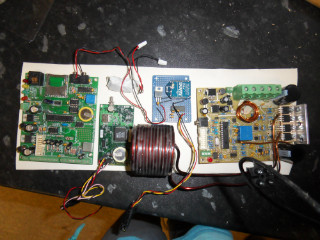 |
| Ben, Martin and Ian were welding today, continuing work on the steering mechanism. Hopefully this will be finished today. |
 |
| Luke, Michael, Jacob, Rob and Dan were fitting the bonnet to the car. They've been measuring it out and have started to drill it in. The final touches will be made at a later date so the car is as aerodynamic as possible. |
 |
| Dawn, Louise and Gareth have been working on the nose cone. This will absorb any shock (because it is foam) so will keep the drivers safe even if they do encounter a crash (fingers crossed!). The foam will slow down an impact, reducing the force on the driver should they crash. |
 |
| Also Gareth has being looking at the motor he wasn't bolting it yet but was making some adjustments. |
 |
2013-04-22: The Rush to finish the car
|
Gareth has been making a "new" M plate for our cars steering. This is also a vital piece of equipment for our car steering. |
 |
| Ben and his dad have being doing some welding for the rollbar. This is also another important part of the car. |
.jpg) |
| Luke, Becky and Louise have been busy making some parts for the steering. This will help make our steering accurate and hopefully make an impack on our up coming races. If we did not make these very important parts then our car would not be to the standard we had wanted it to be. | |
| Dawn and Tom have been continuing the work on the sprockets from last week. They have being working really hard to finish the work accurately and to the best standard as possible. | |
| Martin and Dan have been working alongside the lathe. |
 |
| Louise and Gareth have re-fitted the brake plates on the wheels. This was only done on 2 of the wheels. |
2013-04-15: Continuing rollbar work
|
We have an unexpected visitor today. Steph is showing her the notice board, which we use for publicity. It shows how we made the car and how it has developed over the recent years. |
 |
| Tom has tried out the new car, so we can make adjustments if required on the rollbar. This will make sure it is safe and the right height for us to race in the coming year. |
 |
|
Gareth and Ben are drilling holes for the steering column which will help our car to develop steering more accurately. |
 |
|
Dawn and Tom are continuing their work which they had previously started last week, which includes drilling some holes to help improve the gears. |
 |
|
Dan has used a hacksaw to cut off the end of our roll bar to make it the right length to fit in our car. This will make the roll bar safe as well as making is as aerodynamic as possible so our car will go fast and be safe. |
 |
|
Paul, Martin and Jacob are using the lathe to make the rear sub axels, which will contribute the the completion of our axles. |
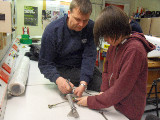 |
2013-04-08: Back from easter break
| Gareth has been set to work on the computer, improving the design of the aerial which will then fit on rollbar fairing in the future. This will help us to create a streamlined shape in the future, helping us to improve the speed and efficiency of the car. |
 |
|
Paul, Luke, Rob, and Michael have been fitting the rollbar to the main frame of the car. First drilling the holes(checking it was accurate) and then finally bolting it in place. this rollbar will make it safer in future races if the car happens to roll over. |
 |
| Dawn, Tom and Terry were drilling and tapping the sprockets so they can fit into the car. They were using both the lathes and a cutting machine to make sure that the pieces of metal were the required length and size needed. |
.jpg) |
| Jacob and Martin were making aluminium stub axels using the lathe which is going to go on our car. This will help us to complete this part of the car because essential for the car to be able to race. |
 |
| Dan has been working on a program to control the car's power automatically. Using simple linear equations he was able to simulate a race in which we did 121 miles! (This may be a tad optimistic). |
 |
2013-03-18: Continuing work
| The car is making progress although, as a team, we are slightly worried about the approaching deadline. We are scheduled to have the first race in June, but at the current rate of work we are unsure whether the car will be finished or not in time. We are aiming to get it done by doing work outside of school so we will be able to have a few races before the final so the car will be able to reach it's full potential. |
.jpg) |
| Today we continued welding and nearly every member of the team had a chance to weld some part of the car with one of the parents (who is practised in welding). The main roll bar is finished and small brackets have been attached to a few of the poles inside the car so they will be able to screwed into the frame easily and safely. |
 |
| The seat has made tremendous progress and today saw it finished with added padding and reinforced sewing around the edges to hold it in place when the drivers enter the car. We have also sewed this around in the corners so it will fit comfortably onto the tube that we have arranged for the seat. |
 |
| Designing is nearing the end, with a few adjustments still being made throughout the building process. This is making the car slightly better bit by bit, so hopefully the overall design will be as good as we can possibly make it. |
 |
| A few tubes have also been re-done due to them changing the shape of the frame and altering the design. A couple of people worked to replace these poles and they have also been welded onto brackets. |
 |
| Hopefully the car will be finished in time, and we hope to see you all in June! |
 |
2013-03-11: After half term
|
After coming back from half term we got straight back into building the new car. New tubes have been made for the steering which will help to support the frame and provide colums needed for our steering mechanism to work. |
 |
| We have also been continuing our work on the car seat, cutting and sewing the entire shape together as well as adding padding. Currently we are adding webbing to the edge to strengthen the seat and stop if from fraying. |
 |
| Gareth is still adjusting his designs slightly, providing us measurements for the steering and working out how things are going to adjust and fit in the car. |
 |
| The roll bar is also making progress. The main shape has been completed and welded together, and all that is needed now is to weld it into the car and fit it in place. The tubes to do this have been finished and have been tested to see if they fit into the frame work. |
 |
| Also, one of our team members turned 18 this week so we had a small celebration during Greenpower before getting back to work on the car. |
 |

2013-02-05: Summary up to February half term
| Progress is steady on the new car, the chasis / frame has been made and work is now progressing on the Roll Bar, Electronics, Steering & seat; still lots to do. |
 |
| Steel was selected as material for the roll bar, the car, mainly designed by Gareth, has some interesting shapes & curves which he assures us aids aerodynamics but do give us challenges for manufactuing it ourselves. Were were lucky to have access to some pipe bending equipment as this has allowed us to bend & form the materials and lay them out on the drawing which he produced. |
 |
| The seat design has been sketched and the material also selected, upolstury fabric was chosen as its strong, we will use a wading pad inside for comfort. This will be strengthened using upolstury webbing. The design will be a hammock style incorporating a 6 point harness for safety. The material is tough so practice will be required on scrap material to ensure the stiching is strong. |
 |
| Most of the components for the steering have been made, we will learn about welding them together after half term. |
 |
2013-01-28: Work on RR9
Tonight we have all been doing different jobs on the new car:
|
 |
 |
2013-01-21: The frame gets finished
The main frame is finally completed. Will the older pupils feet fit though, its quite thin at the front ...
 Our largest (6ft 4" and size 13 feet) F24+ team member managed to get in, but can they stand it for a race ?
Our largest (6ft 4" and size 13 feet) F24+ team member managed to get in, but can they stand it for a race ?
More lathe working on the steering components and the rollbar/rear axle support has been designed using 2D CAD and printed onto paper at a 1:1 scale.
Work on the programming for the updated control system also got underway with modifying the simulator so that different algorithms written in 'C++' could be experimented with as well as learning 'C++'.
2013-01-12: Back after Christmas
|
It was back to work after the Christmas festivities. A bit of a slow start to the year. First we had a meeting to work out where we were and what had to be done. Also items to purchase were aired so we can make up a list. We also wrote our pitch for funding to a possible organisation who may provide some funding for all of the cars at CSS. Fingers crossed. The tube bender was in today, and so the upright tubes were bent and the top and bottom of the chaissis were bolted together. This was followed by cutting the main tubes to the correct length (we left them oversize untill the last minute :) ) The chasis is getting there. |
 |
|
More lathe work for the steering conmponents continued with Martin taking more of the pupils aside to do this. Some more work on the overal design continued, how to mount the motor. Yes, this should have been done earlier ! Meanwhile work on updating the schools Greenpower notice borads was going on. The 2013 race dates had been published, so the Central South Regional Heat on the 9th June looks like the date to target ... |
 |
2012-12-17: Christmas
Tonight we have measured some parts of the steering (from the old car) to help us improve our new car. We got two people to measure the part of the steering to get our measurements as accurate as possible. We are also making some metal bungs for the new steering which will be tougher than plastic ones and more appropriate for the steering mechanism. Gareth has been working on the designs for the steering; this will help us insure our steering is the best it can be so that we can make sure it all fits in with the car designs.
Here are some pictures of the steel bungs being made on the Lathes.
 |
 |
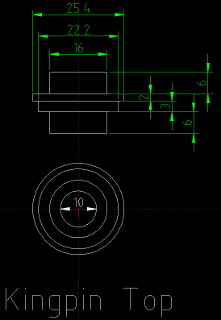 |
But as it's Christmas, we haven't spent much time working on the car. Instead, we have been enjoying the festivities and having fun! We will get back to work after the holidays  Merry Christmas everybody!
Merry Christmas everybody!
2012-12-10: Bolting tubes together
Today we continued from last week by starting to bolt the pre-cut tubes together. Unfortunately we lost a tube but this problem was quickly overcome by a few team members making another one. We then started to create a frame for the car, bolting together the main tubes and letting the car slowly take shape. We followed the plans very carefully, checking the measurements to make sure the tubes were the right size and matched our diagram. This meant we could create our desired frame shape needed in our car.
Other members of the team continued to work on the steering and the design stage is nearly complete. We continued work on pieces of metal to go with the wheel brackets, sawing and shaping the metal so it would fit easily and securely over the edge of the metal. These have now been finished, and are ready to put on our new car.
Next week we are going to try and bend some of the pipes so they will all fit comfortably with our car frame. We will also continue work on the steering design, hopefully getting us closer to finishing this.

2012-12-03: Connecting the tubes
After completing all the tubes last week, we'd started to try putting them together. This week, we continued making progress by drilling holes in the tubes for the main frame of the car, ready for them to be put together with the other tubes.
As well as doing this, Gareth and Dan have continued their work on the steering design, weighing up the positives and negatives of each steering type. We have canceled it down to a type of 'tank steering' and the previous design of a 'twist grip throttle.' These are the only two methods that we feel would fit comfortably into our car without us having to make any major changes.
Some members of the team spent the time sawing and filing metal tubes for brackets for the steering and roll-bar bases, ready for later on when we start putting the car together.
We have also been arranging this year's Greenpower Christmas Social, and we are all thoroughly looking forward to this Saturday. So all that's left to say is Merry Christmas!
2012-11-25: Bending the tubes and fitting self tappers
 |
The children are better at saftey than these adults! Safety goggles must be worn in the workshop when using dangerous machines - tut, tut adults! |
 |
Being taught by an older student what is needed to be done next. |
 |
The basic frame of our new car! It's starting to take shape... slowly |
 |
Drilling the pipes for the basic frame of the car |
 |
Drilling, continued |
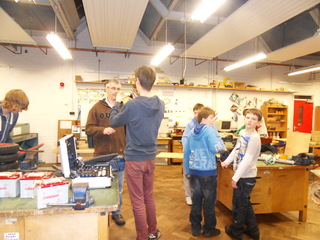 |
Another team working in the workshop next door as they build their own new car |
2012-11-21: 19/11/2012
After a discussion about the steering and the accelerator, the team got back to work on cutting and bending the tubes started from the previous week. The plans made earlier by team member Gareth Barnaby saw a high improvement on aerodynamics (showing an improvement in speed) but there were issues as whether the team members would be able to fit inside the car well. In order to check this, temporary pieces of wood were placed in the original car - Rotary Racer 8, and we were able to see that the size of the car wouldn't be an issue.
2012-11-12: The build starts
We actually started building RR9 today. The 2D CAD chassis tube designs, top and side, had been printed onto large A0 (?) sheets of paper and stuck together with sellotape. The length of the tubes needed was measured accurately (...)
The first thing to do was to cut and bend the 4 main front to back 25.4mm aluminium tubes. One of the parents had a tube bender that was used to do this.
The length of the cross tubes had to be measured taking account of the plastic bungs used to join the tubes. The vernier caliper came out! Once this was done some of the team started cutting the cross tubes to length while the main tubes were being bent.
The tubes were cut using a pipe cutter. Some tube end de-buring was called for. A big wooden mallet was used to "push" the bungs into the end of the tubes.
A good nights work and the core tubes bent and cut. More next week.
2012-11-05: Work on Rotary Racer 9
Today at Greenpower, the Rotary Racer team was working on our current car, and continued the planning for our new car, Rotary Racer 9. Other members were also going around taking photos for our site, and also writing a report on the season.

- The project plan was gone through and a GANT chart of the work shown: GANT Chart.
- Terry, Kevan, Jacob, Becky and Tom spent some of the evening measuring the radius of our wheels, and then began to draw prototype schematics for the steering mechanism for RR9.
- Louise, Jacob and Michael took the top and sides of RR8 and measured the tube positions for Gareth who has done the major new cars design work and needed some dimenstions for the position of seat tubes etc.
- Micheal, Jacob and Dan were taking apart our old motor to find the fault that occured during the Somerset Heat at Merryfield, discovering it to have been an inner magnet that had came loose in its 4 years of service. There was rust behind the magnet ... Some info here.
- Gareth had been working on his laptop, modifying the drawings of Rotary Racer 9's design, altering the dimensions of the rollbar and the back of the chassis.
- Becky and her dad replaced RR8's front tyres with the new ones we intend to use for RR9 to measure the diameter.
- Driver positions with the intended thinner chasis were tested using RR8 and a strip of gaffer tape with Becky, Dan and Gareth as drivers (small to large).
- Also on the computers, Steph had been making a presentation on the team throughout the 2012 Season and our work in the evenings, whilst Dawn wrote up a summary of the 2012 season for the school newsletter and newspapers.
- Finally, Steph, Louise and Jacob had also been walking around with the digital camera, taking photos of our night's work to upload onto the site.
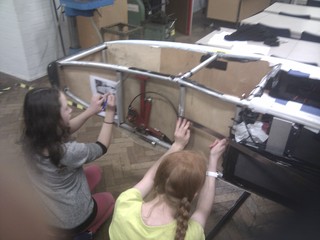 |
 |
We'll update soon.
Rotary Racer
2012-11-01: The Research and Design
The design for RR9 was started in the early part of 2012. The idea was to try and get a new car out during the 2012 season. Unfortunately this did not happen. Most of the time was spent with getting the car working in F24+ races. However the research and design work continued in the background. It was a long process!

RR8 had grown to over 70Kg in weight over the years. So this was an area for improvement. We partially dismantled the car and weighed items.
A spread sheet of all the components and weights or estimated weights for things was made so we could find out where most of the weight resided.

On the electronics side the speed controllers were tested to check on their efficiencies to see if improvements could be made there. To do this our light bulb load rig was used together with a multi meter to measure the input power (volts x Amps) and the output power of the speed controllers under different power level settings.
Meanwhile, the overall cars design was being worked on by the older lads. They are responsible for the cars overall design. They spent a lot of time during Greenpower sessions and at other times working on this. The focused mainly on the aerodynamics and fitting things in the car. Most of the work involved creating and modifying 3D models of the car using a 3D CAD package (Creo ?) and running the design through our Virtual Wind Tunnel software. After each run they looked at the results and the airflow pictures and modified the design to try and improve it.
They had to make sure the core components (driver!, batteries, wheels etc) would work on this design.
Meanwhile ideas for the steering arrangement and rear wheel axle mountings were being thought about.
The basic design will use aluminium tubing joined with plastic bungs as per RR8 and previous Rotary Racer cars. This is the same as GP's goblin cars and can easily be done by pupils.
The design's roll stability was checked using some trigometry on the design files. This was checked using the tilt angle calculator at: http://portal.beam.ltd.uk/greensim/RollMaths.py. The esitamted roll angle for the design was 52 degrees which exceeds what we consider to be a minimum of 45 degrees by a wide margin. So the design will be roll stable.









